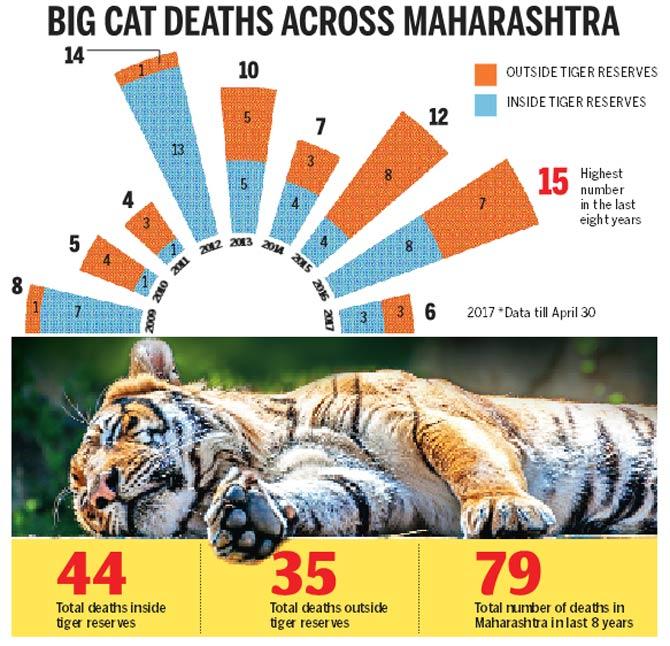According to data compiled by NTCA, of the 567 tiger deaths recorded, 407 have been in the protected tiger reserves while the remaining 161 were in the territorial range jurisdiction


ADVERTISEMENT
All the talk about conservation of tigers is just that: talk. Data compiled by the National Tiger Conservation Authority on tiger deaths across the country has uncovered some shocking statistics that put a question mark on the security apparatus of the so-called 'protected areas' (PAs) or tiger reserves.
Also read: Missing tiger Srinivas found electrocuted
Even as there have been 567 tiger deaths in the last eight years, 407 of them have occurred within the PA boundaries, while the other 161 were outside of these marked locations.
A trend emerges
The NTCA is a statutory body under the ministry of environment and forests and the data for tiger deaths was published on the body's official website Tigernet.
Soon after the death of tiger Srinivas (UK T-10), a viral message suggested that the forest department couldn't be blamed for his death outside the PAs as it is not its jurisdiction; however, the emergent data belies that idea. The maximum tiger deaths (407) over the last eight years - between 2009 to April 30, 2017 - have occurred in the PAs.
However, wildlife experts now feel that the need of the hour is to increase vigilance and patrolling outside the PAs, or the area that comes under the jurisdiction of territorial range of the department.
"As per NTCA data, there have been 35 tigers deaths this year till date across the country, wherein 18 tigers died inside protected areas and 17 outside, which amounts to an almost equal percentage death ratio. The forest department team cannot keep passing the buck to the territorial range or indulge in a blame game, because the ultimate aim is to protect the tiger," said researcher, naturalist and conservation photographer Rajesh Sanap.

Illustration/Ravi Jadhav
Numbers tell a tale
If we compare the 2017 (January to April) tiger deaths to those in the same period last year, the number from last year's 40 has dropped to 36 this year. Meanwhile, last year, Maharashtra saw the death of 15 tigers in the entire year, whereas in the last four months, the state has already lost six - three inside tiger reserves and three outside.
Also read: Tiger dies of starvation in Corbett Tiger Reserve
Even isolating the deaths in Maharashtra between the last eight years, there were a total of 79 tiger deaths, 44 inside reserves and 35 outside, an almost even spread, making the need for protection of all areas an immediate need of the hour.
Wildlife conservationist Kedar Gore, director of the Corbett Foundation, said, "The rate at which the tiger mortality is taking place across the country is a matter of concern. It's high time that the wildlife wing and the territorial wing work in proper coordination with each other, because there are many tigers that stay outside tiger reserves and they are the ones who are more vulnerable. Only then can we bring down the mortality because of poaching, electrocution and other such factors."
"Tigers don't understand the difference between forests under wildlife wing and territorial division. Tiger conservation is a collective responsibility of the forest department, irrespective of departmentalisation," he added.
 Subscribe today by clicking the link and stay updated with the latest news!" Click here!
Subscribe today by clicking the link and stay updated with the latest news!" Click here!






